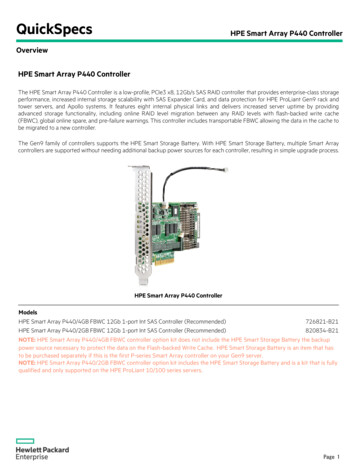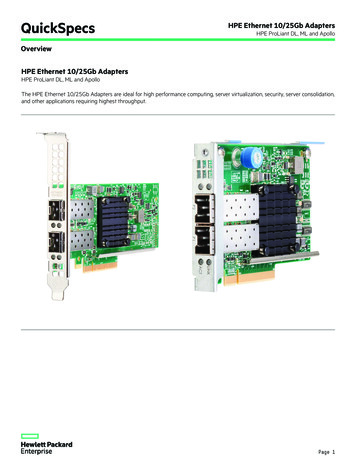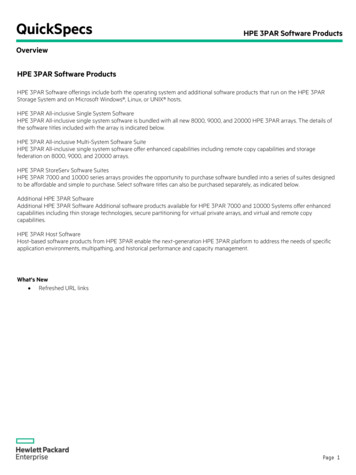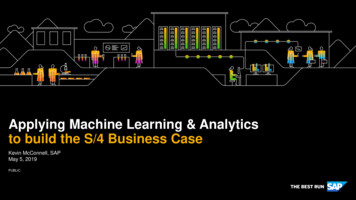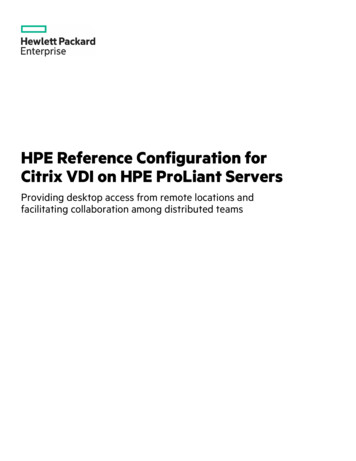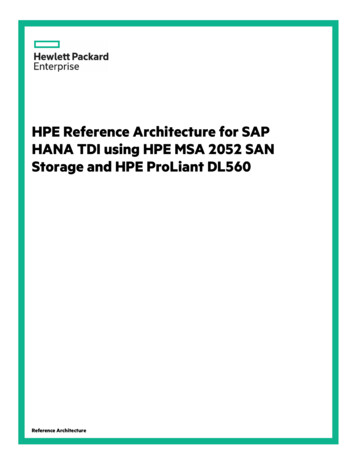
Transcription
HPE Reference Architecture for SAPHANA TDI using HPE MSA 2052 SANStorage and HPE ProLiant DL560Reference Architecture
Reference ArchitectureContentsExecutive summary . 3Introduction .4Solution overview . 6Reference Configurations . 6Design principles . 10SAP HANA .10Servers . 11Storage . 11Networking . 13Storage fabric . 15Management . 17Power . 17Data protection.17Solution components. 20Hardware. 20Networking . 24Software . 26Licensing specifications . 28Best practices and configuration guidance for the solution . 28Server recommendations . 28Storage recommendations . 29Networking recommendations . 32SAP certification . 32Capacity and sizing . 33Storage replication considerations . 34Workload description . 34Analysis and recommendations . 34Key Reference Architecture points . 35Summary . 36Implementing a proof-of-concept. 36Appendix A. Bill of Materials . 36Appendix B. Optional rack configurations . 39Appendix C. Protecting SAP HANA . 41Appendix D. HPE StoreOnce Catalyst Plug-in for SAP HANA . 44Resources and additional links . 46
Reference ArchitecturePage 3Executive summaryWhen SAP announced its new database in 2008, customers were somewhat skeptical; however, today SAP HANA, an in-memory database, hasdemonstrated how the vision of an Internet of Things is possible. The enhanced performance and improved compression of an in-memorydatabase has sparked the imagination of businesses across the globe. These new possibilities make SAP HANA the platform of choice for manymission-critical applications and set a new standard for databases.Along with great possibilities, SAP HANA has created new challenges for IT organizations. With SAP HANA's enhanced performancecharacteristics, the rules appear to have changed around the benefits of traditional IT operations, protection, and disaster recovery. For example,if your backup solution has been solely based on Linear Tape-Open (LTO) tape speeds, can your business survive an SAP HANA outage using aprocess that takes an hour to restore a single terabyte of data?Fortunately, Hewlett Packard Enterprise (HPE) and SAP have partnered for close to three decades to bring our customers high-performing,mission-critical business solutions. And SAP HANA has been at the forefront of our partnership with SAP for the last ten years. HPE is the globalleader for SAP HANA and approximately 50% of all SAP HANA deployments are on HPE systems. Combining HPE servers and storage with HPEPointnext services is key to the HPE SAP HANA solution. HPE was one of the first vendors to certify an SAP HANA appliance; and with theintroduction of SAP’s Tailored Datacenter Integration (TDI), HPE continues its tradition of closely working with SAP to make sure our servers andstorage arrays exceed SAP HANA’s Key Performance Indicators (KPIs) for certification.As we see more organizations shift away from SAP HANA appliances to TDI integrations, customers continue to ask us for simpler solutions thatare more cost effective, scale quickly, and are also highly available. Besides being a major SMB and mid-market storage contender, the HPE MSA2052 SAN Storage system (HPE MSA 2052) using all-flash SSDs has met the rigorous SAP HANA KPIs to be a TDI-certified storage array. TheHPE MSA 2052 is a simple, space-efficient, and cost-effective array with a great deal of versatility. For example, you can directly attach the HPEMSA 2052 to up to eight servers using Fibre Channel. Or, the HPE MSA 2052 can be used as part of a composable storage infrastructure,supporting multitenant data-center architectures.And it is fast! How fast? So fast HPE customers are using the HPE MSA 2052 to load SAP HANA databases connected to HPE ProLiant DLservers, HPE Mission Critical servers, and even to HPE Superdomes. The HPE MSA 2052 can exceed 200,000 input/output operations persecond (IOPS). Its ability to sequentially load an SAP HANA database upon startup is impressive.The HPE MSA 2052 SAN Storage system has a rich set of features that can be used to protect an SAP HANA environment. Due to thedatabase’s continuously updating nature, the HPE MSA 2052’s replication feature makes for an attractive protection option. Data replication toanother HPE MSA storage array is significantly faster than file-based backup solutions, while providing a level of crash-consistent protection witha fast recovery option. With the HPE MSA’s ability to take snapshots of replicated volumes, not only can you reduce recovery time significantly,you can also use snapshots for testing and development.This Reference Architecture shows how to implement the HPE MSA 2052 SAN Storage system to support and protect your SAP HANAdatabase environment, using the latest HPE ProLiant DL560 Generation10 (Gen10) servers. These 2U X86 servers are packed with memoryand CPU horsepower. When coupled with the 2U HPE MSA 2052, you can bundle up to 96 TB of SAP HANA database services into a singlerack.Target audienceThis Reference Architecture has been created for IT systems architects, systems engineers, database administrators, and SAP solution engineersconsidering SAP HANA TDI solutions.
Reference ArchitecturePage 4Document purposeThis Reference Architecture describes the technical and architectural considerations necessary when using HPE MSA 2052 arrays, HPE ProLiantDL560 Gen10 servers, and their supporting infrastructure for an SAP HANA database configuration. This document is specifically written basedon using the following versions of technology. The versions indicated were the available versions at the time of publication. This configurationexceeded all the key performance indicators (KPIs) set forth by SAP for production implementations of SAP HANA 2.0 TDI. HPE ProLiant DL560 Gen10 servers HPE MSA 2052 SAN Storage SAP HANA 2.0 SPS 02 SUSE Linux Enterprise Server for SAP Applications 12 SP3 10 Gb Ethernet 16 Gb Fibre Channel (FC)IntroductionIn 2008, SAP introduced SAP HANA, a new database technology that changed the database market. It was a database boasting exceptionalperformance, deduplication, and capabilities for on-the-fly analytics. To answer the ever-pressing need for faster data access, SAP started themove to an in-memory database model with SAP HANA by building upon a column-based data strategy, rather than the traditional row-basedimplementation. That was ten years ago when servers and mini computers supported 8 to 16 Cores and a maximum of 64 GB of memory.Today, SAP HANA is at the core of mission-critical business and research applications throughout the world. Customers have multiple petabytesof data distributed and replicated throughout their environments. They are trying to keep up with availability due to an ever increasing demandfor data. The sheer volume of data can be overwhelming; however, add the expectation of availability with the need to protect data from disastersand you find yourself with a very challenging IT problem.Fortunately, HPE and SAP have partnered for close to three decades to bring our customers high-performing, mission-critical business solutions.HPE is the number one infrastructure provider for SAP HANA (Gartner Group 2018). Key to HPE SAP HANA solutions are HPE servers, storage,and services. With the introduction of SAP’s Tailored Datacenter Integration for SAP HANA, HPE has seen a large shift in customers moving fromSAP HANA appliances to TDI-certified custom datacenter configurations. SAP HANA customers are continually looking for better solutions tokeep up with and to manage this new world of in-memory solutions.With SAP HANA, the challenge is understanding where traditional database theories align with the new in-memory database paradigm andwhere they do not synchronize. For example, one of the first questions administrators ask is this: “With an in-memory database do I need a highlyavailable storage array to persist my data?” That is a very good question. Consider the following statement from the SAP HANA AdministrationGuide.To maintain optimal performance, an SAP HANA database holds the bulk of its data in-memory. However, SAP HANA also uses persistent storage toprovide a fallback in the event of a fault or a failure.During normal database operation, changed data is automatically saved from memory to disk at regular savepoints. By default, savepoints are set tooccur every five minutes Persisting data to storage for “a fault or a failure” purpose sounds like a backup. Has Tier 1 storage become a backup mechanism with SAPHANA? In some respects, it has. This is a very different perspective from traditional databases, which considered Tier 1 storage persistence asthe original copy of data, and where critical analysis of your storage transactions, queue depths, and spindle counts were essential metrics totroubleshoot or determine database performance. The amount of RAM in your database server was a fraction of your database size and theserver was secondary to how fast your storage array needed to be. Gone are those days when you would watch as your database server’s CPUidled along at about 15% utilization while the storage array maxed itself out.With SAP HANA, the database tables have literally changed from rows to columns. Data is deduped automatically and all data stays resident inmemory. With server memory and CPUs decreasing in price, larger amounts of transactional data are being maintained in memory. Completedtransactions are written to disk as log files, and database differences are written at savepoint intervals of every five minutes to make sure thedatabase can be reloaded upon startup. Welcome to the world of SAP HANA in-memory databases. Instead of operation centers and databaseadministrators needing to keep track of volume sizes as the key indicator of database growth, SAP HANA engineers will be watching KeyPerformance Indicators for memory and CPU usage.
Reference ArchitecturePage 5With server-memory sizes reaching the double- and triple-digit Terabyte ranges, using a traditional backup model to recover an SAP HANAdatabase can cripple an enterprise application. As you look into how to architect an SAP HANA environment, you will find yourself questioningtraditional database backup theories. Here are a few questions you might need to ask: “How do I protect an in-memory database like SAPHANA?” “Will the traditional data protection models work for my organization?” (See Figure 1 below.) “Should I use the three-media rule ofthumb for data backups?” And finally, “Do I allow my database to continually grow, or do I distribute it into multiple database nodes?” Fortunately,HPE and SAP have done the work to address these questions and make sure you have the best available solutions to support your business.Figure 1. Traditional 3-2-1 backup best practiceThis Reference Architecture addresses many of the questions customers are facing with SAP HANA, while providing the best possible TDIsolution using Hewlett Packard Enterprise’s award-winning HPE ProLiant DL560 Gen10 servers, HPE MSA 2052 SAN Storage systems, HPEFibre Channel switches, and HPE Aruba Networking equipment. This document brings together many of the best practices and insights forinfrastructure configuration, operating system (OS) tuning, and protection options available for SAP HANA, as implemented in an HPEenvironment.First we will look at the overall solution design, equipment, and software that makes up this HPE and SAP HANA TDI solution. We will show asimple introductory test and development implementation built upon a single HPE ProLiant server configured with direct connections to a singleHPE MSA Storage array. Next, we will look at a small group of HPE ProLiant servers supported by two HPE MSA Storage arrays. Then, we willshow how this architecture can scale to a data center configuration that can support multiple SAP HANA Database Containers (MDCs). We alsoinclude a review of solution components, followed by a section on best practices that HPE recommends for implementing this solution. The finalsection addresses capacity-planning considerations and options. Appendices have been included to provide information about options of interestrelating to SAP HANA in an HPE environment.As you study this document, we encourage you to follow the HPE Alliances Community website to get the latest announcements anddevelopments about HPE and SAP HANA.
Reference ArchitecturePage 6Solution overviewThe SAP HANA Tailored Datacenter Integration (TDI) certification process was established to help customer’s select equipment componentsthat work together in a customized and supportable production environment. Although TDI-certified equipment is highly encouraged, SAPHANA does not require TDI-certified equipment for development, test, and other implementations; TDI-certified hardware is only required forproduction environments. HPE understands how important your business is and believes any solution we recommend should meet and exceedthe expected production support levels for your solution, independent of its usage. Your business is always in production to HPE.This Reference Architecture uses HPE ProLiant DL560 Gen10 servers in conjunction with HPE MSA 2052 SAN Storage systems to implementan SAP HANA 2.0 SPS 02 production IT environment. The solution includes redundant 10 Gb Ethernet connections to support IP networking tofront-end and back-end network workloads, and 1 Gb Ethernet switches for out-of-band management and heartbeat VLANs. Storageconnectivity is provided by multi-path, 16 Gb Fibre Channel (FC) switch fabrics.HPE sees data protection as an essential part of a production environment. Protecting an SAP HANA database can be done in many ways withvarying levels of Recovery Point Objectives (RPO) and Recovery Time Objectives (RTO). This Reference Architecture shows how features of theSAP HANA Cockpit and HPE MSA 2052 can create a simple protection model for SAP HANA. This model uses file-based backups, virtualvolume replication and snapshots to support backup, clone, and copy configurations. Appendix C: Protecting SAP HANA, addresses some of thechallenges and pitfalls of protecting SAP HANA, while Appendix D: HPE StoreOnce Catalyst Plug-in for SAP HANA, provides information aboutthe HPE StoreOnce Catalyst Plugin for SAP HANA, which can provide the best data protection plan for the SAP HANA database environmentwith the HPE MSA 2052 Storage systems.Reference ConfigurationsIntroductory configurationThe introductory configuration for this Reference Architecture is included to show how a very basic server and storage array configuration canbe used and expanded for testing purposes. This simple configuration includes a single HPE ProLiant DL560 Gen10 server and a single HPEMSA 2052 array. They are connected using a direct-attached FC connection, instead of a SAS or iSCSI connection because we anticipate you willwant to move these two devices to a storage-switch fabric, as you attach more servers to the storage array.Figure 2. Introductory single-server configuration
Reference ArchitecturePage 7HPE has many servers that are SAP HANA TDI certified, which could be implemented as part of this Reference Architecture. For this ReferenceArchitecture we selected the four-processor, HPE ProLiant DL560 Gen10 server because it is an economical server for SAP HANA from bothcost and data center footprint considerations. At 2U, this compact server supports both SAP HANA scale-up and scale-out configurations withmemory that scales from 384 GB to 6 TB of RAM. If you are creating a composable infrastructure, this server is a great option. Other HPEcompute servers compatible with SAP HANA TDI are shown in Figure 3.Figure 3. HPE compute blocks for the SAP HANA TDI portfolioThroughout this Reference Architecture, each server has been configured with two dual-port FC Host Bus Adapters (HBAs), allowing multiple FCports to connect directly, or through a switch, to the HPE MSA 2052 SAN Storage arrays. This enables the SUSE SLES or Red Hat operatingsystem’s multipath SCSI manager to manage all available paths to the array.NoteEven though you can directly attach servers to the array through Fibre Channel, we recommend using a switch fabric in most configurations. Thiscreates a redundant, high availability (HA), scale-up path for the HPE MSA array to support multiple servers and protection options. Because theHPE MSA 2052 supports directly attached Fibre Channel (FC) connections, this introductory configuration does not require a Fibre Channelswitch; however, using a pair of FC switches will make the process of expanding this configuration easier in the future.Six-server configurationAlthough the introductory configuration is a great testing setup, you should strongly consider a group of HPE ProLiant DL560 Gen10 serverswith multiple HPE MSA 2052 SAN Storage arrays for your investigation of the production features of SAP HANA. This six HPE ProLiant DL560server grouping with two HPE MSA 2052 arrays is the configuration used for this Reference Architecture. It provides enough resources to test aproduction SAP HANA scale-up or scale-out configuration. With this Reference Architecture configuration, you can test multiple Worker andStandby nodes, as well as SAP’s system replication. However, to really test a Disaster Recovery (DR) configuration, you will want to implementone of these configurations at two different locations.
Reference ArchitecturePage 8NoteFor scale-out configurations you will need an NFS source for a shared volume, which is not a feature of the HPE MSA 2052 Storage array. Thissix-server configuration can help you determine what data protection configuration works best for your business needs and what will fit withinyour budget.Figure 4. Six-server configurationData center rack configurationThe final configuration of this Reference Architecture shows how two six-server configurations can support a data center rack configuration. Thiscomposable design shows how to get the best server density in a rack, while providing a component-based assembly of commodity productscommonly used in service provider data centers.
Reference ArchitecturePage 9By using 2U HPE ProLiant DL560 Gen10 servers and 2U HPE MSA 2052 SAN Storage arrays, a single rack can support twelve, 6 TB SAPHANA database servers. That is 72 TB of SAP HANA database server nodes in a single rack. That is a very economical solution if yourenvironment requires multiple database nodes under 6 TB. If you need a single-node system with greater than 6 TB of database space, considerHPE’s Superdome Flex, Integrity Superdome X, or MC990X systems.Figure 5. Twelve-server data center configuration
Reference ArchitecturePage 10Design principlesWhen considering this SAP HANA production environment with HPE ProLiant servers and HPE MSA Storage arrays, we used the same designprinciples used for designing Highly Available (HA) and Disaster Recovery (DR) environments. This includes considerations for servers, storage,networking, storage fabric, management, and data protection. This system-design process ensures the overall configuration will exceed the SAPHANA TDI requirements, while maximizing how the solution will be managed, protected, and recovered by the IT engineering staff. This designincludes the following elements of the system solution: SAP HANA Servers Storage Networking Storage
Key to HPE SAP HANA solutions are HPE servers, storage, and services. With the introduction of SAP's Tailor ed Datacenter Integration for SAP HANA, HPE has seen a large shift in customers moving from SAP HANA appliances to TDI-certified custom datacenter configurations. SAP HANA customers are continually looking for better solutions to
